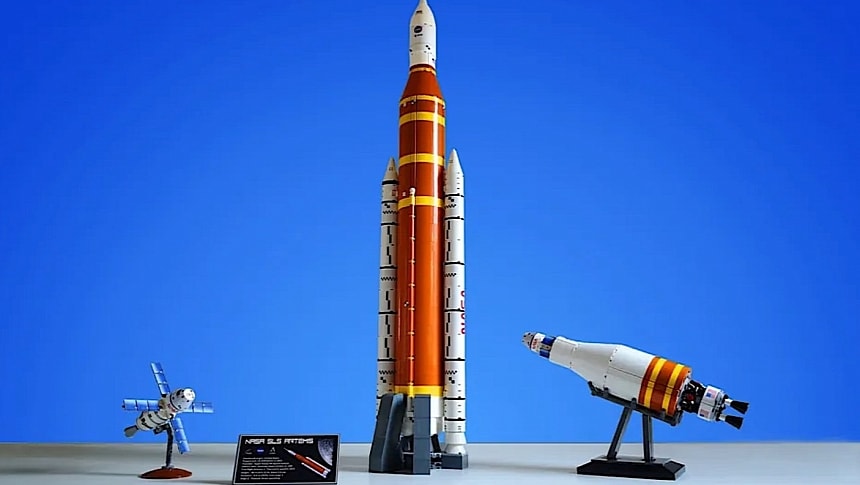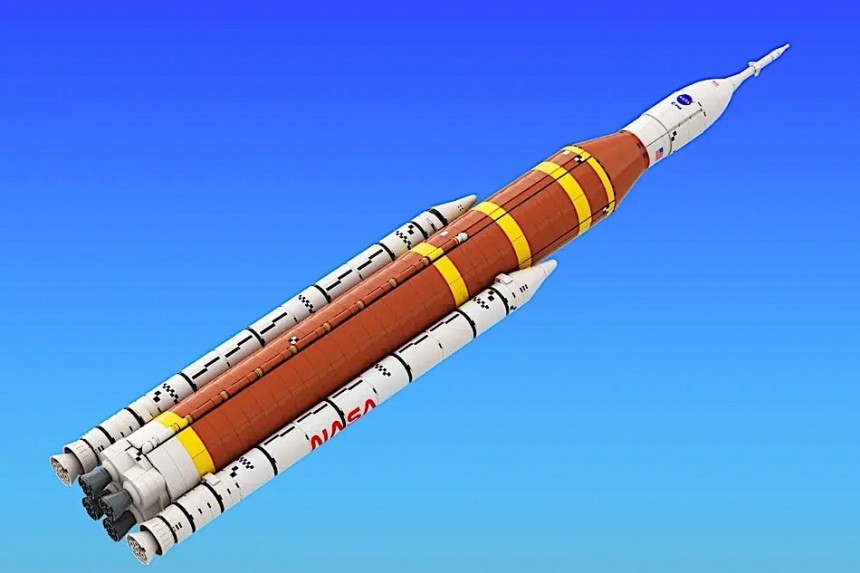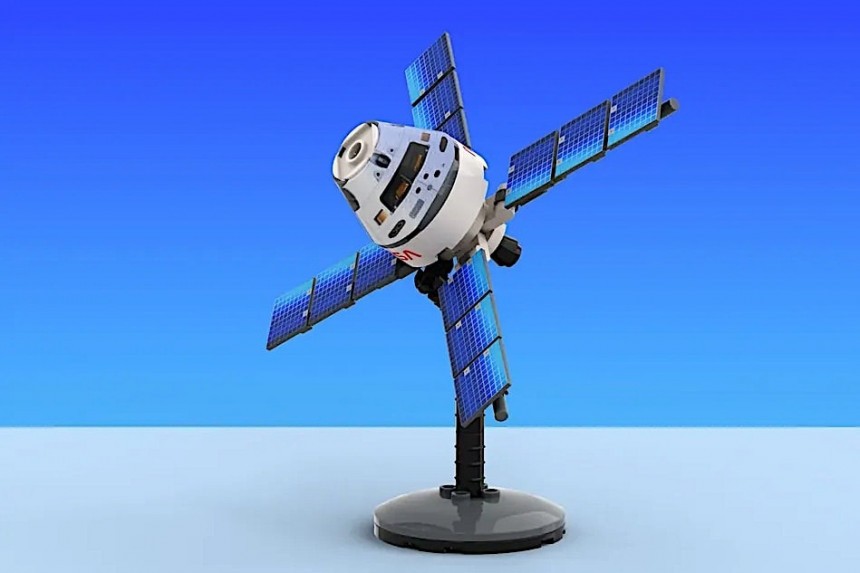In November 2022, the world witnessed the flight of the Space Launch System rocket for the first time. Coming at the end of a rather short development program (work on it started in 2011) and following a couple of botched attempts, the launch officially marked the start of the Artemis Moon exploration program.
The Space Launch System, or the SLS as the world knows it, is the rocket meant to push the Orion spaceship on a course to the Moon. And it's not only a rocket, but the most powerful one ever flown on an actual mission. It's a title it will lose to the SpaceX Starship, which will be twice as powerful, but for now it proudly holds on to it.
How powerful was the SLS? During the Artemis I flight, the Block 1 version of the hardware let loose no less than 8.8 million pounds of thrust, 15 percent more than the previous record holder, the Saturn V rocket of the Apollo Moon program.
That huge kick came from a combination of four RS-25 engines, which developed 512,000 pounds of thrust each, and two solid rocket boosters that made up for the difference.
The rest of the numbers that make up the SLS are not less impressive. The Block 1 (the rocket will evolve for future missions, and it will grow even more powerful) was 322 feet tall (98 meters), weighed 5.75 million pounds (2.6 million kg), and cost roughly $20 billion to make.
And soon every one of us could get a taste of all of the above numbers, right on our desks, at a 1:110 scale: enter the NASA SLS Block 1 and Block 1B rockets in glorious LEGO form.
The plastic brick set you're looking at is the work of Matthew Nolan and Valerie Roche, and it was submitted for the second time as part of LEGO Ideas, the program meant to allow the Danish toymaker to tap into the limitless pool of the public's imagination and draw new design from there.
The set is something LEGO Ideas fans may have seen before, because the people behind the project had it listed there before the first launch in the new Moon program. After the Artemis I launch, the second attempt, with an updated and improved design, allowed the duo to reach the 10,000 backers goal, sending the toy SLS under review for potential production.
So, what are we dealing with?
This thing is actually not a single set, but a 2-in-1 one that comprises a total of 2,661 small bricks of plastic. The 2-in-1 part means at the end of the assembly process you could be left with two different versions of the SLS rocket and Orion capsule, in either Block 1 (meant for Artemis missions I, II, and III) or Block 1B configuration (for missions IV and V).
When assembled both sets include the rocket, the Orion spacecraft, and a stand to display them on. In both cases the rocket and spaceship can be displayed independently, or together on the stand either vertically or at an angle of 45 degrees.
The SLS Block 1 needs no less than 1,614 bricks to be assembled, and when the assembly process is all over the rocket ends up measuring a massive 35 inches in height (89 cm). Block 1B, which needs 1,997 bricks, is even bigger, with a height in complete form sitting at 39 inches (one meter).
The vertical stand for the set shows a replica of the famous launch pad 39B at the Kennedy Space Center and is made of 233 bricks. It comes complete with the articulated mast that holds the rocket in place.
The inclined stand, meant for the upper stage of the rocket, requires 177 bricks. Additionally, there is also a 48-brick Orion stand, a display plate, and four solar wings for the spaceship.
As said, LEGO currently lists the project as under review, meaning a decision has not been taken yet on how this set will actually look like in production form. It's obvious what we all hope the decision will be, and we will of course let you know all about when the set enters production.
There is no word yet on how much such a cool toy would cost, but we all know LEGO is not one to shy away from slapping high prices on its products, because it knows people will generally pay.
Back to the real Space Launch System, the rocket was supposed to take off for the second time this year, this time with astronauts on board, during the first crewed mission of the Artemis program.
Just as we stepped into the new year, NASA announced it is pushing the Artemis II mission to 2025, and the first Moon landing of the modern age even further, to 2026. Let's hope this LEGO set comes to the market before that, to keep us company as we wait.
How powerful was the SLS? During the Artemis I flight, the Block 1 version of the hardware let loose no less than 8.8 million pounds of thrust, 15 percent more than the previous record holder, the Saturn V rocket of the Apollo Moon program.
That huge kick came from a combination of four RS-25 engines, which developed 512,000 pounds of thrust each, and two solid rocket boosters that made up for the difference.
The rest of the numbers that make up the SLS are not less impressive. The Block 1 (the rocket will evolve for future missions, and it will grow even more powerful) was 322 feet tall (98 meters), weighed 5.75 million pounds (2.6 million kg), and cost roughly $20 billion to make.
And soon every one of us could get a taste of all of the above numbers, right on our desks, at a 1:110 scale: enter the NASA SLS Block 1 and Block 1B rockets in glorious LEGO form.
The plastic brick set you're looking at is the work of Matthew Nolan and Valerie Roche, and it was submitted for the second time as part of LEGO Ideas, the program meant to allow the Danish toymaker to tap into the limitless pool of the public's imagination and draw new design from there.
So, what are we dealing with?
This thing is actually not a single set, but a 2-in-1 one that comprises a total of 2,661 small bricks of plastic. The 2-in-1 part means at the end of the assembly process you could be left with two different versions of the SLS rocket and Orion capsule, in either Block 1 (meant for Artemis missions I, II, and III) or Block 1B configuration (for missions IV and V).
When assembled both sets include the rocket, the Orion spacecraft, and a stand to display them on. In both cases the rocket and spaceship can be displayed independently, or together on the stand either vertically or at an angle of 45 degrees.
The SLS Block 1 needs no less than 1,614 bricks to be assembled, and when the assembly process is all over the rocket ends up measuring a massive 35 inches in height (89 cm). Block 1B, which needs 1,997 bricks, is even bigger, with a height in complete form sitting at 39 inches (one meter).
The vertical stand for the set shows a replica of the famous launch pad 39B at the Kennedy Space Center and is made of 233 bricks. It comes complete with the articulated mast that holds the rocket in place.
As said, LEGO currently lists the project as under review, meaning a decision has not been taken yet on how this set will actually look like in production form. It's obvious what we all hope the decision will be, and we will of course let you know all about when the set enters production.
There is no word yet on how much such a cool toy would cost, but we all know LEGO is not one to shy away from slapping high prices on its products, because it knows people will generally pay.
Back to the real Space Launch System, the rocket was supposed to take off for the second time this year, this time with astronauts on board, during the first crewed mission of the Artemis program.
Just as we stepped into the new year, NASA announced it is pushing the Artemis II mission to 2025, and the first Moon landing of the modern age even further, to 2026. Let's hope this LEGO set comes to the market before that, to keep us company as we wait.











